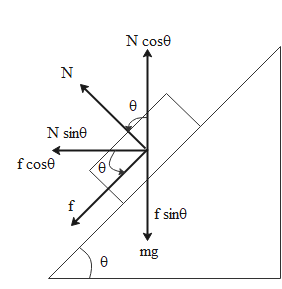Answer
395.4k+ views
Hint: First of all, we need to draw a free body diagram for the car moving on the curved road showing the frictional force, force due to weight and the normal reaction force acting on the car. Then by obtaining equations of motion from the diagram and solving them for velocity, we can get the required answer.
Complete step-by-step answer:
We are given a car which is moving on a curve of radius R. The road is banked at an angle $\theta $. The coefficient of friction between the tyres of the car and the road is given as ${\mu _S}$. Based on this information, we can draw the following free body diagram which shows the road banked at the given angle.

In the diagram, we have the weight of the car mg, normal reaction force N and the frictional force f between road and car and their components. From the diagram, we can see that the following components can be equated in their magnitude.
\[
N\cos \theta = mg + f\sin \theta \\
N\cos \theta - f\sin \theta = mg{\text{ }}...{\text{(i)}} \\
N\sin \theta + f\cos \theta = \dfrac{{m{v^2}}}{R}{\text{ }}...{\text{(ii)}} \\
\]
Now we can divide equation (ii) by equation (i). Doing so, we get
$\dfrac{{{v^2}}}{{Rg}} = \dfrac{{N\sin \theta + f\cos \theta }}{{N\cos \theta - f\sin \theta }}$ …(iii)
We can write the expression for the friction force as follows:
$
f = {\mu _S}N \\
\Rightarrow {\mu _S} = \dfrac{f}{N} \\
$
Using this in equation (iii), we get
$
\dfrac{{{v^2}}}{{Rg}} = \dfrac{{\sin \theta + {\mu _S}\cos \theta }}{{\cos \theta - {\mu _S}\sin \theta }} \\
\Rightarrow v = \sqrt {Rg\left( {\dfrac{{\sin \theta + {\mu _S}\cos \theta }}{{\cos \theta - {\mu _S}\sin \theta }}} \right)} \\
$
This is the required expression for the velocity of the car. Hence, the correct answer is option B.
So, the correct answer is “Option B”.
Note: It should be noted that we have written the second equation on the basis of the fact that the horizontal component of the normal reaction force provides the necessary centripetal force required to move the car on the curved turn of the road. While moving on the curved road, the car requires a centripetal force to move in a curve.
Complete step-by-step answer:
We are given a car which is moving on a curve of radius R. The road is banked at an angle $\theta $. The coefficient of friction between the tyres of the car and the road is given as ${\mu _S}$. Based on this information, we can draw the following free body diagram which shows the road banked at the given angle.

In the diagram, we have the weight of the car mg, normal reaction force N and the frictional force f between road and car and their components. From the diagram, we can see that the following components can be equated in their magnitude.
\[
N\cos \theta = mg + f\sin \theta \\
N\cos \theta - f\sin \theta = mg{\text{ }}...{\text{(i)}} \\
N\sin \theta + f\cos \theta = \dfrac{{m{v^2}}}{R}{\text{ }}...{\text{(ii)}} \\
\]
Now we can divide equation (ii) by equation (i). Doing so, we get
$\dfrac{{{v^2}}}{{Rg}} = \dfrac{{N\sin \theta + f\cos \theta }}{{N\cos \theta - f\sin \theta }}$ …(iii)
We can write the expression for the friction force as follows:
$
f = {\mu _S}N \\
\Rightarrow {\mu _S} = \dfrac{f}{N} \\
$
Using this in equation (iii), we get
$
\dfrac{{{v^2}}}{{Rg}} = \dfrac{{\sin \theta + {\mu _S}\cos \theta }}{{\cos \theta - {\mu _S}\sin \theta }} \\
\Rightarrow v = \sqrt {Rg\left( {\dfrac{{\sin \theta + {\mu _S}\cos \theta }}{{\cos \theta - {\mu _S}\sin \theta }}} \right)} \\
$
This is the required expression for the velocity of the car. Hence, the correct answer is option B.
So, the correct answer is “Option B”.
Note: It should be noted that we have written the second equation on the basis of the fact that the horizontal component of the normal reaction force provides the necessary centripetal force required to move the car on the curved turn of the road. While moving on the curved road, the car requires a centripetal force to move in a curve.
Recently Updated Pages
In a flask the weight ratio of CH4g and SO2g at 298 class 11 chemistry CBSE

In a flask colourless N2O4 is in equilibrium with brown class 11 chemistry CBSE

In a first order reaction the concentration of the class 11 chemistry CBSE

In a first order reaction the concentration of the class 11 chemistry CBSE

In a fermentation tank molasses solution is mixed with class 11 chemistry CBSE

In a face centred cubic unit cell what is the volume class 11 chemistry CBSE

Trending doubts
Which are the Top 10 Largest Countries of the World?

Difference Between Plant Cell and Animal Cell

Give 10 examples for herbs , shrubs , climbers , creepers

Fill the blanks with the suitable prepositions 1 The class 9 english CBSE

Difference between Prokaryotic cell and Eukaryotic class 11 biology CBSE

Change the following sentences into negative and interrogative class 10 english CBSE

Write a letter to the principal requesting him to grant class 10 english CBSE

Name 10 Living and Non living things class 9 biology CBSE

Black foot disease is caused by the pollution of groundwater class 12 biology CBSE



